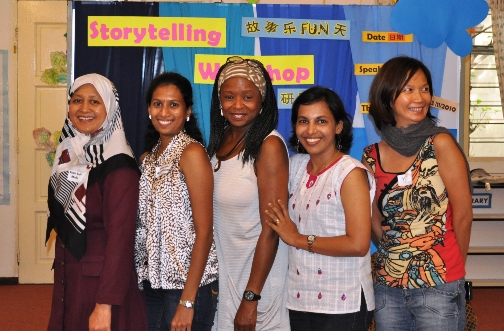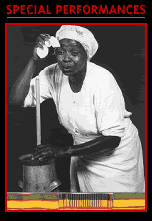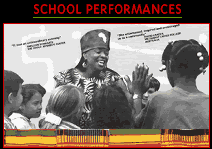|

|
|
|
"There
is wisdom in the old tales, and in the tales of the old, that hold
truths
that we need to know today"
Grammy nominated storyteller Diane Ferlatte
is a multi-award winning performer who has captivated audiences
across six continents. In addition to historical & personal stories,
Diane draws from a deep well of folktales, myths, legends, & fables
to inform, entertain, & inspire all. While many of her stories &
songs have African and African American roots, she loves to tell any
story that holds truths touching upon our common humanity, our
history & our culture. She believes that telling and listening to
each other’s stories not only enables us to learn about each other,
but also to understand each other better. She views storytelling as
a traditional art form that can promote literacy, imagination, and
values in the young. Through stories, songs, sign language, humor
and audience participation, she brings her tales to life while
accompanied by her musical sidekick Erik Pearson on banjo & guitar.
The program/workshop selections that
follow are available upon request. Each program can be
scheduled from 45 to 90 minutes in length. Workshops can be from 90
minutes to 4 hours in length.
Youth/Family Programs
-
1. Wickety Whack, Brer Rabbit is Back;
from the mouths of slaves, stories that helped us
to survive.
- 2.
We Were There;
not Black History, but Blacks in American
History.
-
3. Aesop Alive and Well;
the fables of Aesop brought to life with music & song & Diane's
special zest.
-
4. Knick Knack Paddy Whack;
playful blending of traditional songs and stories for young
children.
-
5.
The
Dream of a King;
stories
& songs that honor Martin Luther King Jr. & his legacy.
-
6.
Walking Through the Bush;
stories from Africa that have lessons for today.
- 7. Train Without
Tracks; unique stories & songs about the
quest for freedom on the 'Underground
Railroad'.11.
-
8.
Have I Got a Story to Tell; family stories for
the young and old tailored for each audience.
-
9.
The Spirit of Freedom; tales
of the struggles and triumphs of African-Americans.
-
10. Joyful
Traditions;
a holiday song and story concert.
-
11.
From Earth to Sky;
stories that celebrate mother earth & our need to preserve it.
-
-
Adult Programs
- 1. Penny For Your
Thoughts; Diane's very personal
stories of crossing cultural/racial
barriers.
-
2.
Thicker Than Water;
stories
that show the power and joy of connecting with one another
in our common
humanity.
-
3.
The Missing Rib, The Spirit of Women;
celebrates the strengths and unique gifts of
women.
-
4.
Haunted Bayou;
ghostly tales, spirits have souls too.
|
| |
|
|
|
Diane
has co-authored and performed in several theater pieces. Along with
colleague Beverly Patton-Miller, she developed a one-woman show,
Sapelo, Time is Winding Up. This show evolved after
her month long immersion in the West African Gullah folk culture
on Sapelo Island, one of the Georgia Sea Islands. She tells the
stories of life in the Hog Hammock community of Sapelo through her
characterizations of the slave descendent residents there. She continues
to maintain her love and affection for the people of Hog Hammock
and has returned there annually for the past ten years.
In
collaboration with other artists she has developed and performed
in other projects including the Memory Project, Dreaming Backwards,
commissioned for the San Francisco Exploratorium. Along with Joanna
Highgood of ZACCHO Dance Theater and Linda Tillery and the Cultural
Heritage Choir, Diane worked on and toured in Invisible Wings,
a commemoration of slaves seeking freedom on the Underground Railroad.
CRITICS
CORNER
"Splendid!...The `Sapelo´ piece
is truly a jewel."
National Conference of Peacemaking and Conflict Resolution
"The
writing was excellent, her characters were well drawn and were executed
beautifully"
A. Vernon Lapps Ph.D. Mansfield University, Pennsylvania
"It
was the best session we´ve had in twenty years...`I had
tears in my eyes, I could really imagine
what it must have been like to be there´"
Consumnes River College, California
"Ferlatte´s
presence, her performance, her style, her music, her rhythm, and
the way she moved from one character to another, in a one woman
show atmosphere, thrilled the audience and made history come to
life"
California Center for the Arts, Escondido
"`Sapelo´was
a truly moving experience...your artistry helped us to all `go
there´ and in
the process gain some insight and understanding"
Roy Furshpan
Center Arts, Humboldt State University, California
work
|
|
|
 |
|
Bringing
Stories to Life
This workshop is for anyone interested in exploring ways to add
life to your stories. Discover the power of a well-told story through
small group exercises, presentations, and examples from my own stories.
We will discuss storytelling techniques and guidelines. How do you
effectively pass on your story? Getting in touch with the whole
story, verbal and nonverbal, through our senses; movement, gestures,
voice, facial expression, emotions, and characterization. You don´t
have to be an actor to be a good storyteller. You only need an imagination.
Culturally
Speaking
This workshop is for anyone who loves stories. We will explore and
discuss memories, thoughts, and feelings in a cultural sense. You
will use stories from your own personal experiences to help you
learn, understand, and interact with other cultures. Exchanging
stories across cultures may be the best way to understand and know
another culture
`Remember
only this one thing´, said Badger, `The stories people
tell have a way of taking care of them. If stories come to you,
care for them. And learn to give them away where they are needed.
Sometimes a person needs a story more than food to stay alive.
That is why we put these stories in each other´s memory.
This is how people care for themselves.´ From Crow and
Weasel by Barry Lopez
Stories
as a Teaching and Survival Tool for African Americans
This workshop will give you a chance to experience and discuss the
importance of storytelling in African and African American culture.
When the Africans were taken from their homeland, they were stripped
of their language, religion, music, dance, and family structure,
in short their entire culture. Everything was taken away but their
undying spirit to survive and to keep on keeping on. If you want
to know about a people and their culture, listen to their stories.
Sheroes
and Heroes
Who are the heroes? Where are the sheroes? What is a hero? This
workshop will give us a chance to think about and look back at the
sheroes in our own lives. Some of our first heroes showed up in
folklore. We will discuss the qualities of "heroes" found
in folklore and in our own lives. Sometimes we tend to look in the
wrong place for heroes. We will discuss the power of shero and hero
stories to inspire and provide courage.
Combining
Song and Story
This workshop will look for the songs, the chants, the rhymes in
stories. Discussing and looking at different ways to combine singing
with storytelling. Creating songs that fit the story add spirit,
enrichment, and audience participation. Do you have to be a good
singer? No, but willing to have fun with singing. Join in a playful
experience with storytelling.
What
a Character!
Every story needs a character or characters. Looking at narration
verses what the characters have to say. Discussing ways of developing
characters in the story. How can the teller best express the wicked
witch, the wise old man, the trickster, the hero, to help the listener
visualize the characters. What behaviors, character traits, and
mannerisms are appropriate to each? To do this requires a personal
understanding of each character.
Let´s
get the Rhythm of the Hands
Before there was rap there was handclap. In the "folk process"
songs and stories are generally passed on from adult to child. With
handclap games the process is different. These games are passed
on from child to child. Unfortunately, parents and teachers have
become too modern. Interpersonal games are hardly played at all.
There is no attempt to preserve handclap games or to participate
with the children in them. The life of handclap games depends upon
generations of children passing them on to the next generation.
You too can play a part in preserving these early handclap games
which teach the creative use of language and rhythm.
Let´s
Get Personal
Looking at some of the stories making up who we are. Looking at
some of the stories in our own lives that should be told. The personal
stories are the glue that binds us together. We discover our common
humanity through our personal stories. This workshop will help us
to see and develop those personal stories.
CRITICS
CORNER
"Our sincere appreciation...evaluation
after evaluation and pledge card after pledge card mentioned a commitment
of participants to take more time to listen to others and to treat
people with greater respect and dignity"
Kern Network of Children, Kern County, California
"It
was wonderful to be reminded of the power and richness of the `simple´
art of storytelling"
Penrhos College, Australia
"It
inspired me to see some of the events from my own life as stories
worth telling"
The California Literature Project
"Many
of the participants stated that they felt you were the highlight
of the two day training. They were motivated to energize and invigorate
the storytelling they already do with young children in their classrooms
every day"
California Early Childhood Mentor Program
school
|
|
|
|
"Time
and again stories reveal to us the common threads of our imaginations,
the common ground of each of our cultures"
While Diane loves to tell stories to adults and families, school
performances are what she loves the most. It is here that she feels
she has the greatest impact as the stacks and stacks of letters,
drawings, thank you notes, and handwritten stories from thousands
of school children attest to. Her vast repertoire and ability to
relate make her equally popular with all ages from pre-school through
high school. Singing and signing (American Sign Language) are an
integral part of these performances. While many performances can
be theme oriented along the program types listed above, Diane´s
main focus is to promote reading-readiness, visual imagery, imagination,
and character/moral development.
Diane gets so many call backs it is sometimes difficult for her
to keep track of what stories she has told at what schools. The
following is typical:
`Ferlatte
asked her audience of kindergartners through fourth-graders
what stories she had told them last year. As student after student
gave a detailed recitation of the tales, Ferlatte seemed surprised
and delighted over the strong impression she had left. Satisfied
with the answers to her pop quiz, she spun a new story, this
one about Anansi the spider´.
Sally Ryen, Davis Enterprise
School
performances run from 45 minutes to one hour depending on the age
and grade level. School appearances generally consist of one to
three assemblies, depending on the school size and grade levels
involved.
Storytelling
a Teaching Tradition
Teaching tool--Storytelling is
a way of "saying without saying" (values, morals) and
enhances retention of lessons being taught.
Literary skills--improves all aspects
of language arts skills and vocabulary expansion. A sense of story
structure and the telling and retelling aids reading and writing
skills as well as oral skills.
Emotional development--self esteem,
self-confidence--stories provide role models for encountering and
overcoming adversity. Learning to tell their own stories enhances
self-esteem and builds confidence in public speaking.
Stretching
the Imagination--When you use words alone to weave images,
the child soon learns the way into the rich world of the mind. Listening
skills are developed. Mental imagery links to reading achievement.
Intimacy--There
is a special magic in the sharing of a story with a child. This
is a gift you give to children, a sharing of imaginations.
History--Stories
frequently focus on historical personalities, events, and eras.
Social/Cultural--offering
authentic experiences of other cultures, expressing diversity, introducing
and promoting conflict resolution.
Music--learning
to use rhythm, music, and singing as a creative, fun, and harmonious
experience. Using music and rhythm to teach generous listening.
CRITICS
CORNER
"She was fantastic! I was amazed by the
way she held everyone´s attention! I felt as if I were "in"
her stories."
3rd Grade Teacher, Le Jardin Academy, Kailua, Hawaii
"She
was like watching a movie."
"I felt like the room was on fire and everyone was alive."
2nd Grade Students
"Your
participation helped to link today´s children to a variety
of cultures and to become aware of the unity we all share."
Education Department, Los Angeles Philharmonic
"We
have asked Diane to perform for Cambodian, Vietnamese, Japanese,
Hispanic, African-American, Chinese, and Hmong children. Regardless
of her audience´s cultural heritage, Diane touches the lives
of these people with power and poignancy."
William McBride, Ph.D., National Language Arts Consultant McDougal
Littell/Houghton Mifflin
"I
was moved to tears feeling the impact Diane was making on all who
have the opportunity to hear her. What power an arts experience
holds! The 4th-8th graders at Mesa were riveted."
Barbara Leonard, Artistic Director, Education Department Los
Angeles Music Center on Tour
|
|
|
| |
|
 |



